Samstag, 5. Mai 2018
Beekeeping excursion
beekids, 16:57h
On Tuesday, 17 April 2018 we visited two beekeepers and pheasant farm with the students of the veterinary technician.
In the pheasant farm in Beltinci, we saw the breeding of pheasants and partridges. Everything begins with eggs that are disinfected before they are deposited in the hatchery. After the hatching, where the eggs turn, they are transferred to the another chamber where the chickens are hatched.
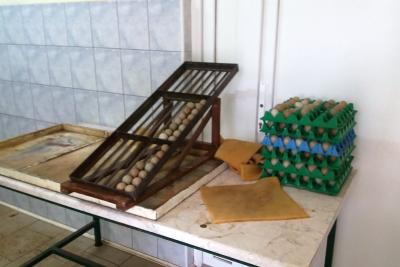
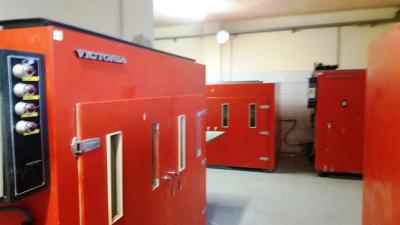
There are no small chicks in this season, so we could only see adult pheasants and quails. Some animals are sold to the hunting families, others are hunted.



After visiting the pheasant farm we went to the Beekeeping Tigeli in Prlekija. We arrived in a beautifully decorated Mediterranean garden surrounded by beehives.

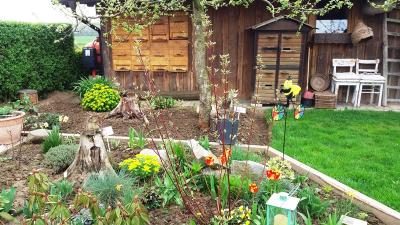
The Lady presented us their activities and briefly restored the basis of beekeeping. The beginnings of the Beekeeping Tigeli date back to the year 2001 when they bought the first bee colonies.
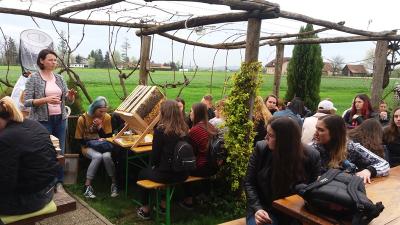
Now they have beekeepers with around 100 bee families - in two stationary beehives and three transport units. In 2005, they inherited a beekeeping museum and began intensively dealing with beekeeping tourism. In addition to the museum, there is a learning beehive where visitors can work on bees. There are many other museum collections of hives and beehives on their property.
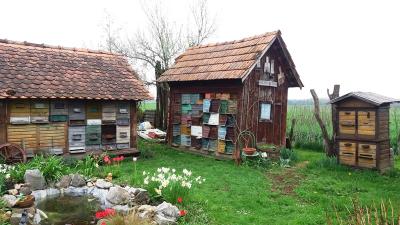
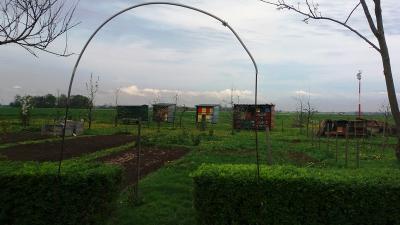
In front of the bee houses there is a beautifully landscaped Bee garden, and in front of their house there is display the life of bees in wooden honey combs. The most beautiful beehive, transformed into a museum, is an octagonal shape with a roofline.
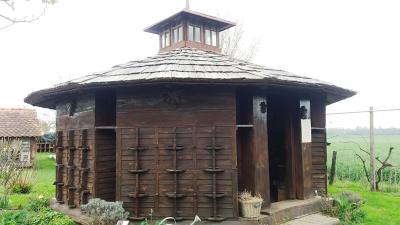

In the beehive, it was possible to beekeeping with 84 families, and the hives were made according to the Naiser system - a hot construction system. The octagonal beehive is still the only specimen in nature and is protected in the cultural heritage of Maribor as an ethnological monument. Various honey packs, hand smokers, wax presses, hives from different periods, a model for making combs, baskets, various literature about beekeeping and many other interesting tools are on display in the museum.


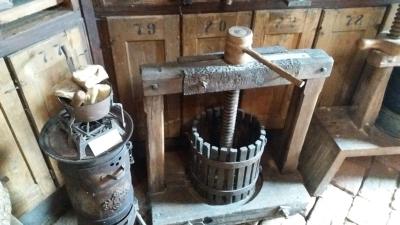
After a pleasant walk through the mediterranean garden and the museum apiary, we went to the our last station – apitourism of beekeeper Šemen Štefan.

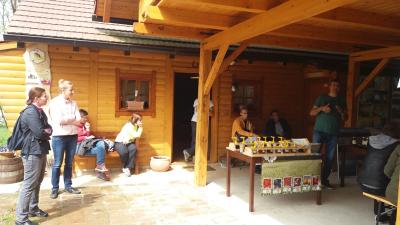
In this beekeeping they work with 700 bee families in the AŽ and DGB hives.

The bees are transported to various pastures throughout Slovenia. They produce all varieties of honey. In addition to selling honey and other bee products, they also offer apitherapy services. In the apiary intended for inhaling aroma of wax, honey and propolis, for visitors are prepared two beds and two comfortable chairs.

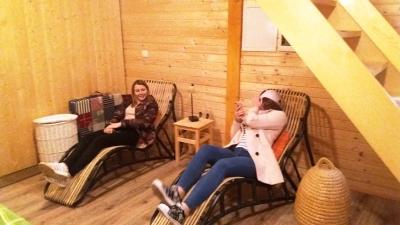
The pleasant space is smudged by an aerosol, which has a great apiterapeutic effect on people and works calming. Behind the apiary is a bedroom, a kitchen, a sauna and a larger space for socializing.
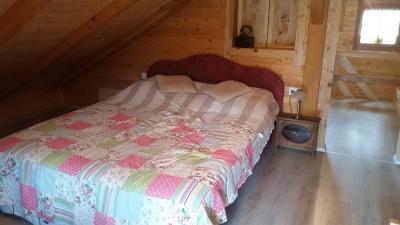
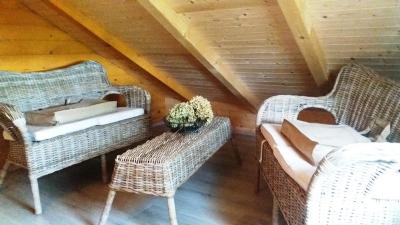
From the balcony above the apiary there is a beautiful view on the pond where the visitor can boats or fish. The beekeeper wisely and in on his own way presented his activity and how he managed to become such a big beekeeper.
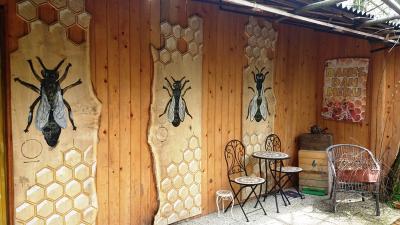
In both beekeepers, we could also taste some good bee products. Strengthened and revived from aerosol, we then set off with the bus to the home.
In the pheasant farm in Beltinci, we saw the breeding of pheasants and partridges. Everything begins with eggs that are disinfected before they are deposited in the hatchery. After the hatching, where the eggs turn, they are transferred to the another chamber where the chickens are hatched.


There are no small chicks in this season, so we could only see adult pheasants and quails. Some animals are sold to the hunting families, others are hunted.



After visiting the pheasant farm we went to the Beekeeping Tigeli in Prlekija. We arrived in a beautifully decorated Mediterranean garden surrounded by beehives.


The Lady presented us their activities and briefly restored the basis of beekeeping. The beginnings of the Beekeeping Tigeli date back to the year 2001 when they bought the first bee colonies.

Now they have beekeepers with around 100 bee families - in two stationary beehives and three transport units. In 2005, they inherited a beekeeping museum and began intensively dealing with beekeeping tourism. In addition to the museum, there is a learning beehive where visitors can work on bees. There are many other museum collections of hives and beehives on their property.


In front of the bee houses there is a beautifully landscaped Bee garden, and in front of their house there is display the life of bees in wooden honey combs. The most beautiful beehive, transformed into a museum, is an octagonal shape with a roofline.


In the beehive, it was possible to beekeeping with 84 families, and the hives were made according to the Naiser system - a hot construction system. The octagonal beehive is still the only specimen in nature and is protected in the cultural heritage of Maribor as an ethnological monument. Various honey packs, hand smokers, wax presses, hives from different periods, a model for making combs, baskets, various literature about beekeeping and many other interesting tools are on display in the museum.



After a pleasant walk through the mediterranean garden and the museum apiary, we went to the our last station – apitourism of beekeeper Šemen Štefan.


In this beekeeping they work with 700 bee families in the AŽ and DGB hives.

The bees are transported to various pastures throughout Slovenia. They produce all varieties of honey. In addition to selling honey and other bee products, they also offer apitherapy services. In the apiary intended for inhaling aroma of wax, honey and propolis, for visitors are prepared two beds and two comfortable chairs.


The pleasant space is smudged by an aerosol, which has a great apiterapeutic effect on people and works calming. Behind the apiary is a bedroom, a kitchen, a sauna and a larger space for socializing.


From the balcony above the apiary there is a beautiful view on the pond where the visitor can boats or fish. The beekeeper wisely and in on his own way presented his activity and how he managed to become such a big beekeeper.

In both beekeepers, we could also taste some good bee products. Strengthened and revived from aerosol, we then set off with the bus to the home.
... link (0 Kommentare) ... comment
Freitag, 4. Mai 2018
Work with bees in april
beekids, 16:05h
The development of the bee family was in full flow in April. In order to stimulate its development, we applied ApiGo preparation and sugar cake to all bee families.
ApiGo is a complementary feed mixture containing glucose, maltoderin and yeast extract.
We mixed 20 g of powder with 1 L of water. The solution is dropped along the honeycomb frames. 50 ml of the solution is used in one hive.
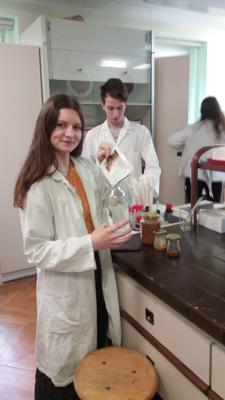
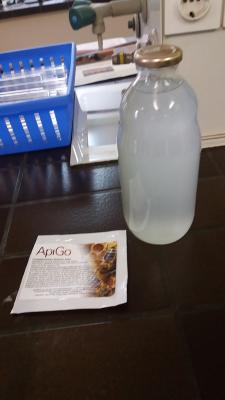

The Medopip sugar cake was laid on the honeycomb frames. In addition to sugar, this cake contain proteins and vitamins, which is a good for stimulation for the development of the bee's families.
Because the weather was bad in March, we also made the first detailed overview of the bee family in April.
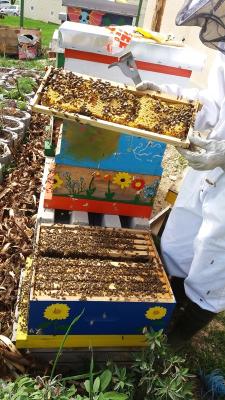
The bee queen began to lay eggs. Because the trees and flowers are blooming, the bees have already accumulated some stocks of nectar and pollen. The abundant flowering led the family to the swarm mood.
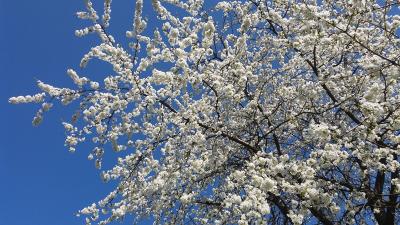
In order to avoid unnecessarily hunting newly born families around the school estate, we decided to make artificial new families – with bees, eggs, larvae, pupae, and honeycombs. So we have created two new hives from the five hives that survive winter.
We also started painting new hives
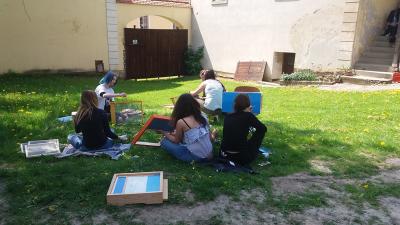
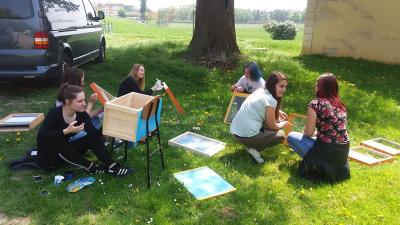
and preparing new honeycomb frames.


In bee garden we also planted several shrubs,
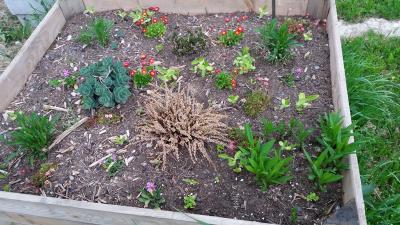
on the pergola we planted vines, wild vines and clematis.

We cut grass around trees and we sowed sunflowers, asters, zinnias, nasturtiums facelia and other honey plants.
ApiGo is a complementary feed mixture containing glucose, maltoderin and yeast extract.
We mixed 20 g of powder with 1 L of water. The solution is dropped along the honeycomb frames. 50 ml of the solution is used in one hive.



The Medopip sugar cake was laid on the honeycomb frames. In addition to sugar, this cake contain proteins and vitamins, which is a good for stimulation for the development of the bee's families.
Because the weather was bad in March, we also made the first detailed overview of the bee family in April.

The bee queen began to lay eggs. Because the trees and flowers are blooming, the bees have already accumulated some stocks of nectar and pollen. The abundant flowering led the family to the swarm mood.

In order to avoid unnecessarily hunting newly born families around the school estate, we decided to make artificial new families – with bees, eggs, larvae, pupae, and honeycombs. So we have created two new hives from the five hives that survive winter.
We also started painting new hives


and preparing new honeycomb frames.


In bee garden we also planted several shrubs,

on the pergola we planted vines, wild vines and clematis.

We cut grass around trees and we sowed sunflowers, asters, zinnias, nasturtiums facelia and other honey plants.
... link (0 Kommentare) ... comment
Competition of consortium of Biotechnical school
beekids, 15:17h
On Thursday, 12 April 2018, the 4th competition of the Consortium of Biotechnical Schools of Slovenia in the knowledge and skills of students took place at the Pyramid Education Center Maribor.
Students competed in baking, cooking, writing art text, knowledge, visual art and photography. The main theme of this year's competition were pumpkin seeds and pumpkin oil.
Our students participated in the competitions. After the introductory speech, the students were divided into groups and assigned to their jobs. During the competition, the mentors had the opportunity to take a guided tour of Maribor. The hosts prepared a pyramid pot and dessert for all participants. We used the rest of the time for a pleasant socializing with friends and acquaintances.
And what did our students achieved?
In the COOKERY category, Lana Križanec competed with Risotto with pumpkin oil and salmon, and Jure Stošić with Pumpkin rissot. Lana was perfect and reached the fifth place and bronze award, and Jure was awarded the 9 th place and recognition for participation.

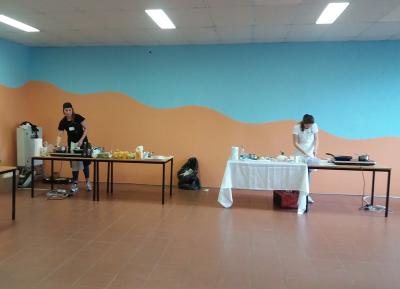
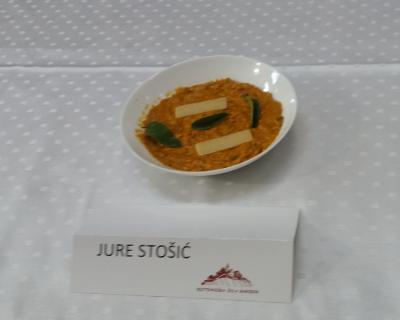

In the category FOODSTUFF, Mario Žebot achieved a golden confession with excellent Pumpkin Pie.

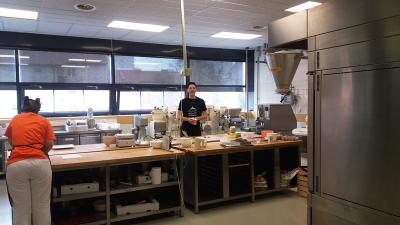
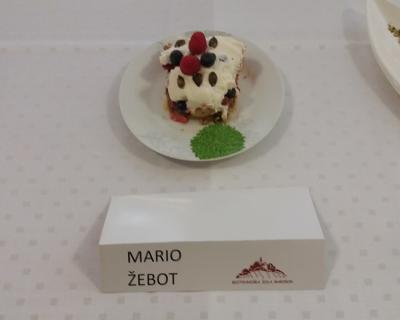
In the VISUAL ART category, student Tjaša Ploj achieved 4th place and a bronze award.
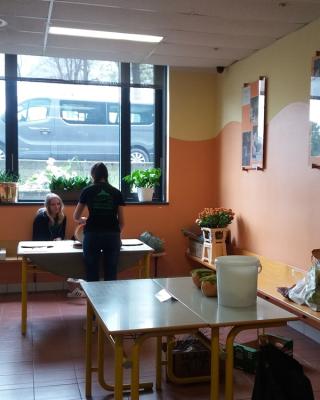
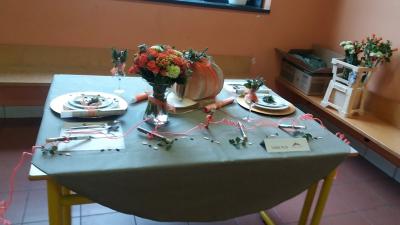
In the CONTRIBUTION/TEXT category student Mihael Unger reached the 8th place and a recognition for participation.
In the KNOWLEDGE category, Ivan Praznik achieved a silver award, while Jakob Pulko received a recognition for his participation.
In the category of PHOTOGRAPHY, Mihej Mukenauer achieved the 4th place and the silver award, while the student Nikita Lenarčič received a recognition for participation.
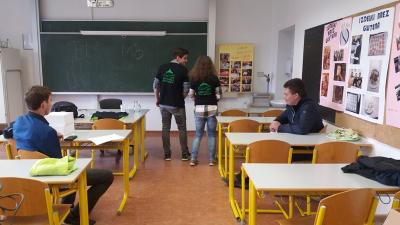
Congratulations to all students for the honors and praise for all the efforts and zeal you have invested in the competition.
Students competed in baking, cooking, writing art text, knowledge, visual art and photography. The main theme of this year's competition were pumpkin seeds and pumpkin oil.
Our students participated in the competitions. After the introductory speech, the students were divided into groups and assigned to their jobs. During the competition, the mentors had the opportunity to take a guided tour of Maribor. The hosts prepared a pyramid pot and dessert for all participants. We used the rest of the time for a pleasant socializing with friends and acquaintances.
And what did our students achieved?
In the COOKERY category, Lana Križanec competed with Risotto with pumpkin oil and salmon, and Jure Stošić with Pumpkin rissot. Lana was perfect and reached the fifth place and bronze award, and Jure was awarded the 9 th place and recognition for participation.




In the category FOODSTUFF, Mario Žebot achieved a golden confession with excellent Pumpkin Pie.



In the VISUAL ART category, student Tjaša Ploj achieved 4th place and a bronze award.


In the CONTRIBUTION/TEXT category student Mihael Unger reached the 8th place and a recognition for participation.
In the KNOWLEDGE category, Ivan Praznik achieved a silver award, while Jakob Pulko received a recognition for his participation.
In the category of PHOTOGRAPHY, Mihej Mukenauer achieved the 4th place and the silver award, while the student Nikita Lenarčič received a recognition for participation.

Congratulations to all students for the honors and praise for all the efforts and zeal you have invested in the competition.
... link (0 Kommentare) ... comment
Freitag, 27. April 2018
Observation of bee families
beekids, 15:59h
Winter farewell and spring came. The bees began to grow their breeds. Due to the warm weather, the fruit trees in the area have flourished, which is an excellent pasture for bees.


We regularly observe bee colonies to see how they evolve. Bee families are in excellent condition. Begins as the period of intensive pesticide spraying, so we will need to monitor the behaviour of bees even more intensively.
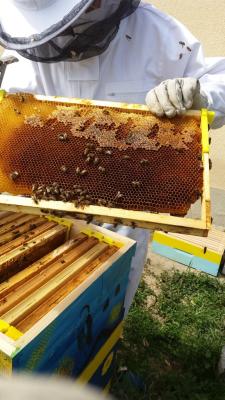
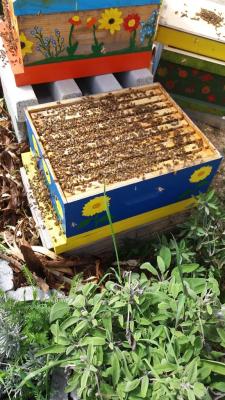



We regularly observe bee colonies to see how they evolve. Bee families are in excellent condition. Begins as the period of intensive pesticide spraying, so we will need to monitor the behaviour of bees even more intensively.



... link (1 Kommentar) ... comment
Pruning of the school's Old Vine 2018
beekids, 15:54h
Many people do not know that three vines that are grown on the school estate are something special. The city of Maribor donated three scions of the Old Vine to our school.
The Old Vine is pruned each year on the anniversary of the establishment of our school by Andrej Podjavoršek, a teacher of viticulture at our school, and Stane Kocutar, the city vinedresser.
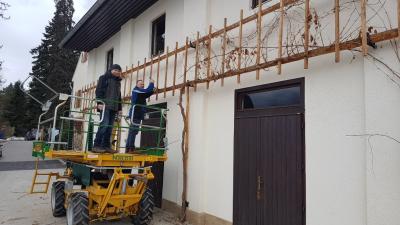
On Sunday, March 11, a small group of people attended the pruning. When the work was done, we tried last year's wine from the old vines.

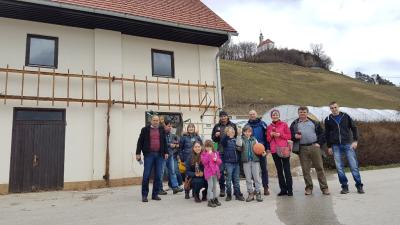
Everyone who was not present this year is invited to attend this event next year, on Monday, March 11, 2019.
The Old Vine is pruned each year on the anniversary of the establishment of our school by Andrej Podjavoršek, a teacher of viticulture at our school, and Stane Kocutar, the city vinedresser.

On Sunday, March 11, a small group of people attended the pruning. When the work was done, we tried last year's wine from the old vines.


Everyone who was not present this year is invited to attend this event next year, on Monday, March 11, 2019.
... link (0 Kommentare) ... comment
Samstag, 21. April 2018
The effectiveness of bee products on bacteria
beekids, 23:56h
We've decided to do a research on how affective honey and other bee products are against bacteria and if it's comparable to antibiotics. With the survey we checked which bee products are most common in our diet. We've done a lot of agar diffusion tests and microbiological investigations in our school's lab and researched a lot of examples under microscopes. We've found out that honeys and products that origin from places around us are actually more effective than those who aren't. But the product that was effective on all of our samples was royal jelly which was predictable since royal jelly is quite well known for it's characteristic. Unfortunately, royal jelly is less known and used among the students . It is delightful that most people use honey in their daily diet.
The disk diffusion agar method tests the effectiveness of antibiotics on a specific microorganism. An agar plate is first spread with bacteria, then paper disks of antibiotics are added. The bacteria is allowed to grow on the agar media, and then observed. The amount of space around every antibiotic plate indicates the lethality of that antibiotic on the bacteria in question.
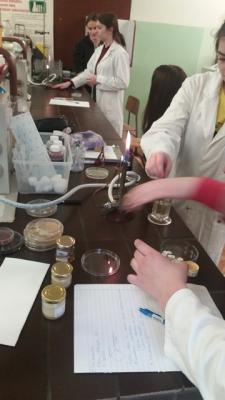
And how we made disk diffusion agar method test?
1. Using an aseptic technique, place a sterile swab into the broth culture of a specific organism and then gently remove the excess liquid by gently pressing or rotating the swab against the inside of the tube.
2. Using the swab, streak the Mueller-Hinton agar plate to form a bacterial lawn.
• To obtain uniform growth, streak the plate with the swab in one direction, rotate the plate 90° and streak the plate again in that direction.
• Repeat this rotation 3 times.
3. Allow the plate to dry for approximately 5 minutes.
4. Use disc without antibiotic and soak them in one of the bee products.
5. Using a flame-sterilized forceps, gently press each disc to the agar to ensure that the disc is attached to the agar.
6. Plates should be incubated 24 h at an incubation temperature of 37 °C (98.6 °F).
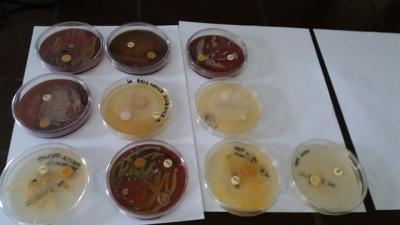
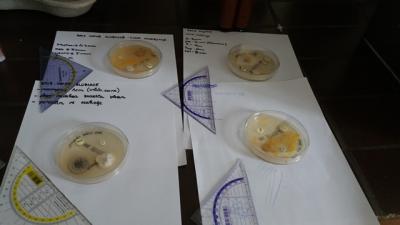

A: The swab of a the throat - human
B: The swab of the oral cavity of the cats
C: The swab of tonsils - human
D: The swab of the throat - human
E: The swab of the throat - human
F: Mastitis cysts in cattle
G: The pustules - human
H: The swab of the the gums - cat
I: The swab of the throat - human
J: The swab of the gums - dog
K: Abscesss - sheep
L: The swab of inflamed joint - goose
M: The swab of inflammated eye conjuctica - cat

The disk diffusion agar method tests the effectiveness of antibiotics on a specific microorganism. An agar plate is first spread with bacteria, then paper disks of antibiotics are added. The bacteria is allowed to grow on the agar media, and then observed. The amount of space around every antibiotic plate indicates the lethality of that antibiotic on the bacteria in question.

And how we made disk diffusion agar method test?
1. Using an aseptic technique, place a sterile swab into the broth culture of a specific organism and then gently remove the excess liquid by gently pressing or rotating the swab against the inside of the tube.
2. Using the swab, streak the Mueller-Hinton agar plate to form a bacterial lawn.
• To obtain uniform growth, streak the plate with the swab in one direction, rotate the plate 90° and streak the plate again in that direction.
• Repeat this rotation 3 times.
3. Allow the plate to dry for approximately 5 minutes.
4. Use disc without antibiotic and soak them in one of the bee products.
5. Using a flame-sterilized forceps, gently press each disc to the agar to ensure that the disc is attached to the agar.
6. Plates should be incubated 24 h at an incubation temperature of 37 °C (98.6 °F).



A: The swab of a the throat - human
B: The swab of the oral cavity of the cats
C: The swab of tonsils - human
D: The swab of the throat - human
E: The swab of the throat - human
F: Mastitis cysts in cattle
G: The pustules - human
H: The swab of the the gums - cat
I: The swab of the throat - human
J: The swab of the gums - dog
K: Abscesss - sheep
L: The swab of inflamed joint - goose
M: The swab of inflammated eye conjuctica - cat

... link (0 Kommentare) ... comment
Samstag, 24. Februar 2018
Cold pressed pumpkin oil
beekids, 15:42h
Pumpkin seeds we picked and dried in the autumn. In the winter we tried to get our own pumpkin oil. For this we bought a little handy kitchen oil press. The press was properly constructed, connected to the mains and slightly warmed. Then the seeds were put into the funnel of oil press. We closed the funnel with the lid and pressed start button. Oil press started to work. We got the pumpkin oil and separately pumpkin tropines.

Why is cold pressed pumpkin oil so good for our skin?
Packed with essential fatty acids, vitamins, minerals, antioxidants, and more, the oil from pumpkin seeds helps soothe, hydrate, protect, and renew your look—making it a great ingredient for anti-aging formulas. The natural nutrients in pumpkin seeks, particularly zinc and vitamin C, help firm and tighten. That same zinc along with natural selenium helps with oily skin, helping it to look healthy and clean. A rich source of vitamin E, which is a potent antioxidant, pumpkin seed oil protects skin from environmental stressors. The essential fatty acids sink deeply into skin to provide long-lasting moisturization without greasiness. These acids also help balance oil, moisturizing dry skin and controlling oily skin. Natural properties of pumpkin seed work great with sensitive skin.
Which cosmetics products we made from cold pressed pumpkin oil?
Pumpkin soap
We melted coconut oil and added pumpkin and sunflower oil.
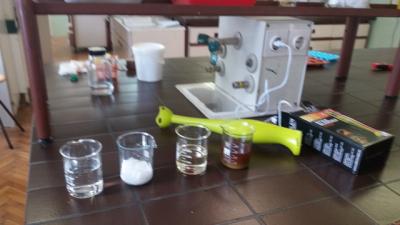
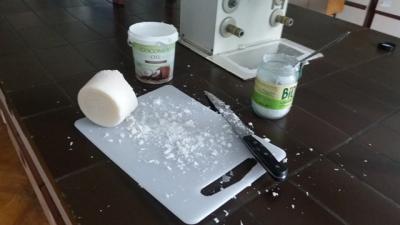
We warmed up this mixture for a while. In the meantime we added sodium hydroxide to the hydrolate. When this mixture has the same temperature as the oils, we mixed them together. We added also some ground pumpkin seeds.
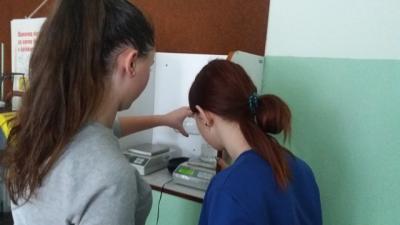
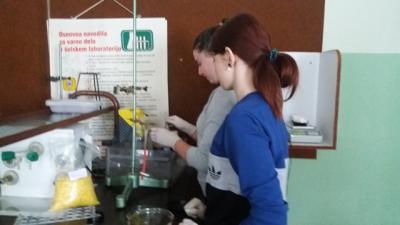
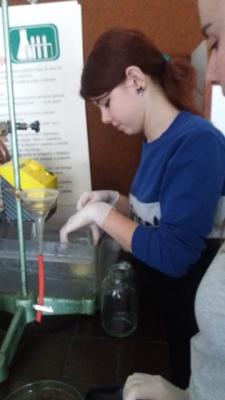
When the mass was like a puding we filled it in a soap models.

We wait three days, than we took soaps out of models. We must leave soaps 6 week to mature.
Pumpkin lip balm
To pumpkin oil we can add olive oil or cocconut oil. We melted all thise oils and added some wax. We poured it in lip balm tubes and waited that they solidify.

Nursing tablets
For them we melted wax an than added him caccao butter and pumpkin oil. We can add this mass also some esential oils and ground pumpkin seeds. We filled the mass in the models and wait that it solidify.
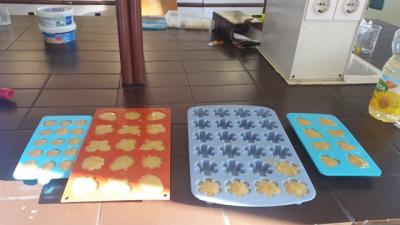
We can use this tablets after showering.
What are other advantages and effects of pumpkin oil?
Cold pressed pumpkin oil has a very beneficial effect on the function of the male prostate.
The oil is rich in a high content of delta-7-sterols that works against prostate enlargement (1g of oil contains 5 mg). Unsaturated fatty acids in conjunction with other substances have a positive effect on the metabolism of helostorel.

Why is cold pressed pumpkin oil so good for our skin?
Packed with essential fatty acids, vitamins, minerals, antioxidants, and more, the oil from pumpkin seeds helps soothe, hydrate, protect, and renew your look—making it a great ingredient for anti-aging formulas. The natural nutrients in pumpkin seeks, particularly zinc and vitamin C, help firm and tighten. That same zinc along with natural selenium helps with oily skin, helping it to look healthy and clean. A rich source of vitamin E, which is a potent antioxidant, pumpkin seed oil protects skin from environmental stressors. The essential fatty acids sink deeply into skin to provide long-lasting moisturization without greasiness. These acids also help balance oil, moisturizing dry skin and controlling oily skin. Natural properties of pumpkin seed work great with sensitive skin.
Which cosmetics products we made from cold pressed pumpkin oil?
Pumpkin soap
We melted coconut oil and added pumpkin and sunflower oil.


We warmed up this mixture for a while. In the meantime we added sodium hydroxide to the hydrolate. When this mixture has the same temperature as the oils, we mixed them together. We added also some ground pumpkin seeds.



When the mass was like a puding we filled it in a soap models.

We wait three days, than we took soaps out of models. We must leave soaps 6 week to mature.
Pumpkin lip balm
To pumpkin oil we can add olive oil or cocconut oil. We melted all thise oils and added some wax. We poured it in lip balm tubes and waited that they solidify.

Nursing tablets
For them we melted wax an than added him caccao butter and pumpkin oil. We can add this mass also some esential oils and ground pumpkin seeds. We filled the mass in the models and wait that it solidify.

We can use this tablets after showering.
What are other advantages and effects of pumpkin oil?
Cold pressed pumpkin oil has a very beneficial effect on the function of the male prostate.
The oil is rich in a high content of delta-7-sterols that works against prostate enlargement (1g of oil contains 5 mg). Unsaturated fatty acids in conjunction with other substances have a positive effect on the metabolism of helostorel.
... link (0 Kommentare) ... comment
Honey soap, Propolis soap and Propolis ointment
beekids, 15:27h
Honey is a popular additive for soap. It has various properties that make it appealing for skincare. Honey contains superior antibacterial, probiotic, and healing properties and is super nourishing and hydrating. If you have any skin care ailments ranging from eczema to acne, honey can help heal them as well as minor wounds.
Propolis contains antioxidant flavonoids, such as quercetin, pinocembrin, galangin and pinobanksin. Other compounds which are found in Propolis include; caffeic acid and hydroquinone, which are among the best known compounds used in most commercial cosmetic formulas to treat acne and other skin related infections. Propolis also contain minerals, such as magnesium, calcium, nickel and zinc, which are beneficial in rebuilding damaged skin cells, as well as giving you nourished, soft skin. Propolis can be used in the treatment and cure of acne. Propolis is also ideal in removing inflammations which cause bacteria responsible for the formation of nodules on your skin.
For honey soap we were melting glyceine base in a water bath. When it was melted we added wax and when it was melted we added honey. We mixed everythin well and added five droplets of essential oil of lavender. The resulting mass was poured into the soap models. We waited one day, than we putted soaps from models.
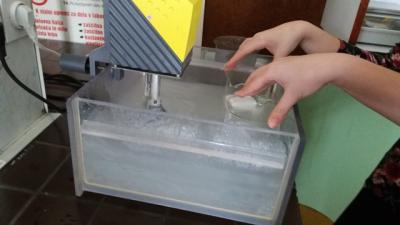
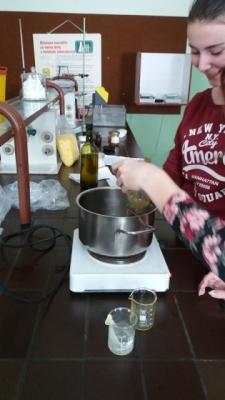
For propolis soap we were melting glycerine base in a water bath. In a water bath we were also heating the propolis tincture, so that the most of alcohol evaporated from it. We heated the honey to 45°C. We added propolis and honey to the malted glycerin, mixed it well and poured it into soap models. We waiting one day, than we putted soaps from models.
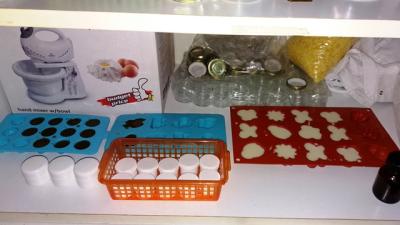
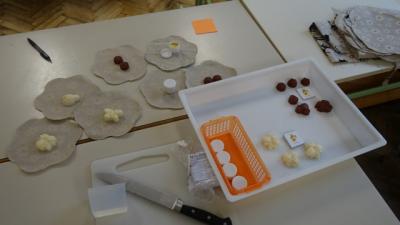
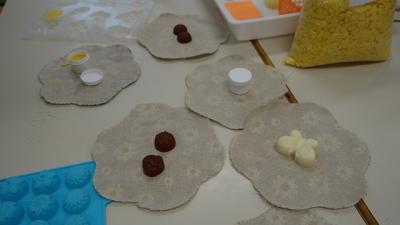
For propolis ointment we were heating separately honey, olive oil, wax, propolis tincture. Than we mixed everything together and poured it into storage jars while it was still warm. To avoid condensation allow the ointment to cool completely before securing with a lid.
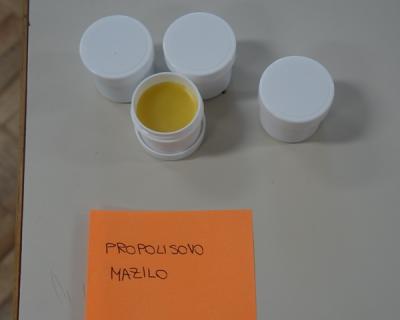
Propolis contains antioxidant flavonoids, such as quercetin, pinocembrin, galangin and pinobanksin. Other compounds which are found in Propolis include; caffeic acid and hydroquinone, which are among the best known compounds used in most commercial cosmetic formulas to treat acne and other skin related infections. Propolis also contain minerals, such as magnesium, calcium, nickel and zinc, which are beneficial in rebuilding damaged skin cells, as well as giving you nourished, soft skin. Propolis can be used in the treatment and cure of acne. Propolis is also ideal in removing inflammations which cause bacteria responsible for the formation of nodules on your skin.
For honey soap we were melting glyceine base in a water bath. When it was melted we added wax and when it was melted we added honey. We mixed everythin well and added five droplets of essential oil of lavender. The resulting mass was poured into the soap models. We waited one day, than we putted soaps from models.


For propolis soap we were melting glycerine base in a water bath. In a water bath we were also heating the propolis tincture, so that the most of alcohol evaporated from it. We heated the honey to 45°C. We added propolis and honey to the malted glycerin, mixed it well and poured it into soap models. We waiting one day, than we putted soaps from models.



For propolis ointment we were heating separately honey, olive oil, wax, propolis tincture. Than we mixed everything together and poured it into storage jars while it was still warm. To avoid condensation allow the ointment to cool completely before securing with a lid.

... link (0 Kommentare) ... comment
Creamed honey
beekids, 15:17h
Creamed honey is thicker and "creamier" than standard honey. It tastes better, feels like velvet on your tongue and won't smoosh out of your sandwich so much.
Contrary to popular belief, creamed honey is not whipped such us whipped cream. It is actually crystalized. The difference between creamed honey and the nasty, gritty honey is the size of the crystals. Creamed honey has tiny, silky, smooth crystals.
How we made it?
First we need a mixer for dough with a pot. We filled it with honey. We added two spoons of crystallized honey and mixed this mixture. We mixed it for 15 minutes, than we cooled it and wait one hour, than we mixed it again for 15 minutes. We repeated that three days during the day. After three days we added the mixture polen, royal jelly and propolis.
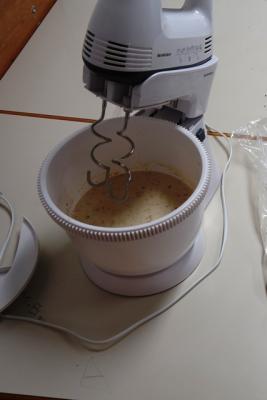
We mixed it 15 minutes and filled it in glasses.
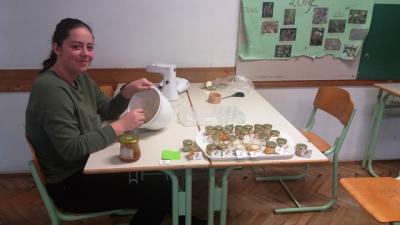

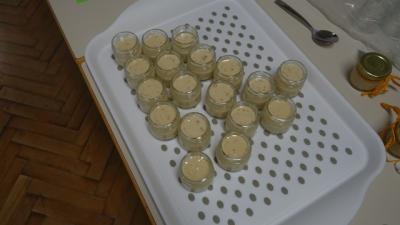
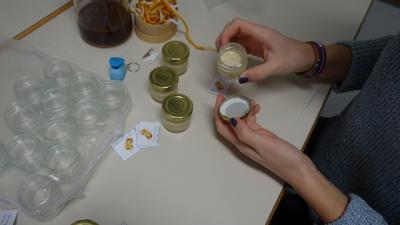
We putted the glasses in a fridge.
Contrary to popular belief, creamed honey is not whipped such us whipped cream. It is actually crystalized. The difference between creamed honey and the nasty, gritty honey is the size of the crystals. Creamed honey has tiny, silky, smooth crystals.
How we made it?
First we need a mixer for dough with a pot. We filled it with honey. We added two spoons of crystallized honey and mixed this mixture. We mixed it for 15 minutes, than we cooled it and wait one hour, than we mixed it again for 15 minutes. We repeated that three days during the day. After three days we added the mixture polen, royal jelly and propolis.

We mixed it 15 minutes and filled it in glasses.




We putted the glasses in a fridge.
... link (0 Kommentare) ... comment
Samstag, 3. Februar 2018
Beekeeping in January
beekids, 16:11h
When the weather was warming and the temperatures reached about 10 degrees, we observed a bee trip from the hives. Bees flew from all our hives. Some of them already carried pollen. Most likely it was the pollen of hazel trees that bloom in the surrounding area.
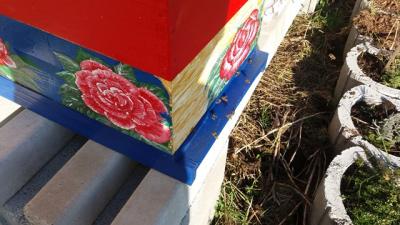
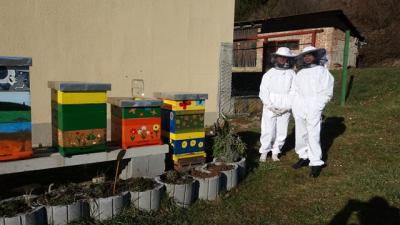
Because the temperature was appropriate, we began working in the bee garden. Our tractor driver Marko brought wooden beams for the pergola, which will support climbing plants.
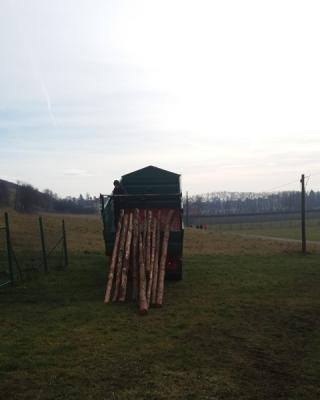
We planted Prunus avium, Erica carnea, Viburnum plicatum `Shasta`, Hedera helix, Vine (Isabella).
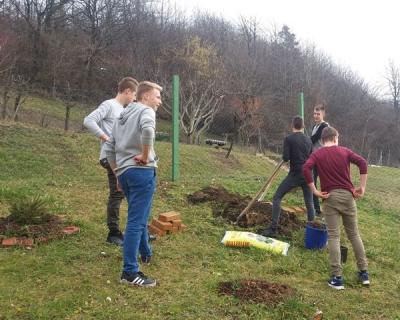
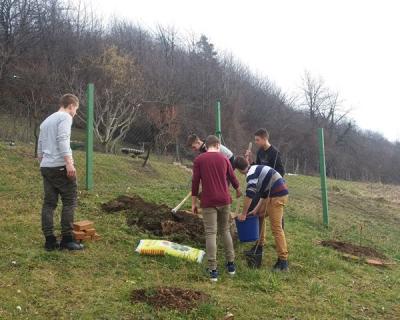
Girls sowed flower seeds into pots.
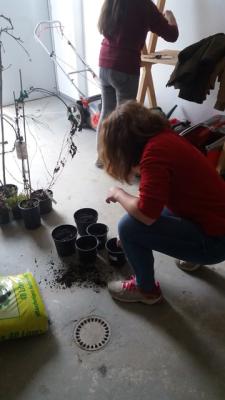
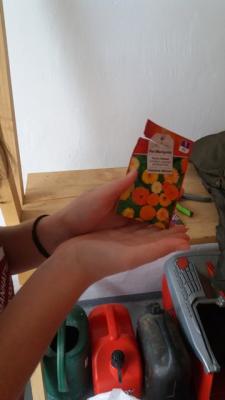
They also transplanted Parthenocissus quinquefolia and Clematis montana into larger pots. When the wooden pergola is finished, we will plant them outside.
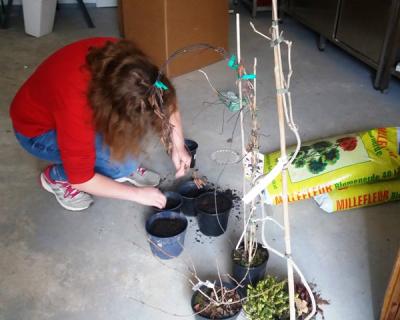

Some students dug the soil and prepared it for planting. They filled the wooden pallet with compost.
We got new hives and we will prepare them for new bee colonies.
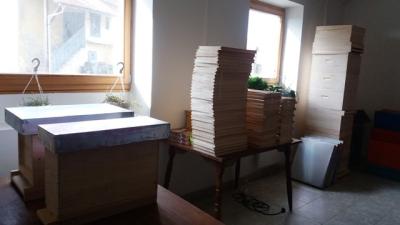


Because the temperature was appropriate, we began working in the bee garden. Our tractor driver Marko brought wooden beams for the pergola, which will support climbing plants.

We planted Prunus avium, Erica carnea, Viburnum plicatum `Shasta`, Hedera helix, Vine (Isabella).


Girls sowed flower seeds into pots.


They also transplanted Parthenocissus quinquefolia and Clematis montana into larger pots. When the wooden pergola is finished, we will plant them outside.


Some students dug the soil and prepared it for planting. They filled the wooden pallet with compost.
We got new hives and we will prepare them for new bee colonies.

... link (0 Kommentare) ... comment
... nächste Seite